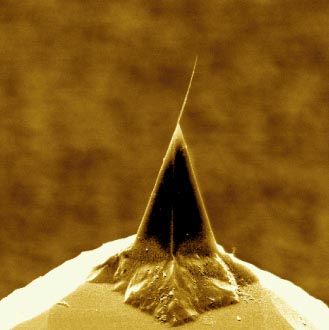Scientists increase luminescence efficiency of carbon nanotubes by 20 percent
 Washington, March 7 : In a new research, chemists at the University of Connecticut, US, have found a way to greatly increase the luminescence efficiency of single-walled carbon nanotubes by 20 percent, a discovery that could have significant applications in medical imaging and other areas.
Washington, March 7 : In a new research, chemists at the University of Connecticut, US, have found a way to greatly increase the luminescence efficiency of single-walled carbon nanotubes by 20 percent, a discovery that could have significant applications in medical imaging and other areas.
The research was performed in the Nanomaterials Optoelectronics Laboratory at the Institute of Materials Science at the University of Connecticut, in Storrs.
Increasing the luminescence efficiency of carbon nanotubes may someday make it possible for doctors to inject patients with microscopic nanotubes to detect tumors, arterial blockages and other internal problems.
Rather than relying on potentially harmful x-rays or the use of radioactive dyes, physicians could simply scan patients with an infrared light that would capture a very sharp resolution of the luminescence of the nanotubes in problem areas.
University of Connecticut Chemist Fotios Papadimitrakopoulos describes the discovery as a major breakthrough and one of the most significant discoveries in his 10 years of working with single-walled carbon nanotubes.
Although carbon is used in many diverse applications, scientists have long been stymied by the element''s limited ability to emit light.
The best scientists have been able to do with solution-suspended carbon nanotubes was to raise their luminescence efficiency to about one-half of one percent, which is extremely low compared to other materials, such as quantum dots and quantum rods.
By tightly wrapping a chemical ‘sleeve’ around a single-walled carbon nanotube, Papadimitrakopoulos and his research team were able to reduce exterior defects caused by chemically absorbed oxygen molecules.
“This process can best be explained by imagining sliding a small tube into a slightly larger diameter tube,” Papadimitrakopoulos said.
In order for this to happen, all deposits or protrusions on the smaller tube have to be removed before the tube is allowed to slip into the slightly larger diameter tube.
According to Papadimitrakopoulos, what is most fascinating with carbon nanotubes is the fact that in this case, the larger tube is not as rigid as the first tube, but is rather formed by a chemical “sleeve” comprised of a synthetic derivative of flavin (an analog of vitamin B2) that adsorbs and self organizes onto a conformal tube.
Papadimitrakopoulos said that this process of self-assembly is unique in that it not only forms a new structure but also actively “cleans” the surface of the underlying nanotube.
It is that active cleaning of the nanotube surface that allows the nanotube to achieve luminescence efficiency to as high as 20 percent. (ANI)